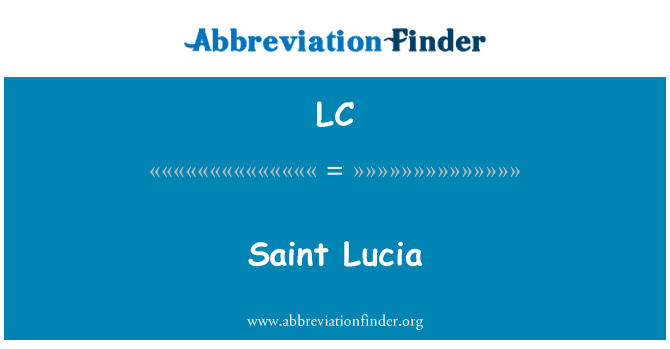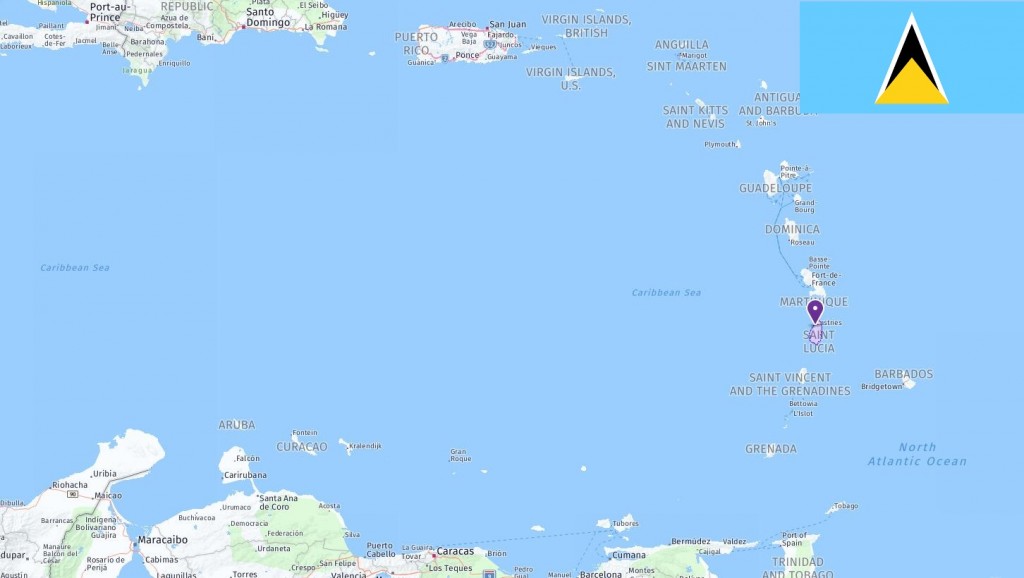LC is the abbreviation for St. Lucia, the 178th largest country in the world. Saint Lucia is a country located in Caribbean, bordering Barbados, Martinique, and Saint Vincent. Castries is the capital city of St. Lucia. Major cities include Castries (population: 19,989), Bisee (population: 12,969), Vieux Fort (population: 4,563), Micoud (population: 3,395), Soufrière (population: 2,907), Dennery (population: 2,859), Gros Islet (population: 2,351), Praslin (population: 1,895), Canaries (population: 1,851), and Anse La Raye (population: 1,245).
Country Profile
- Capital: Castries
- Language: English
- Area: 617 km2
- Population: 178,004
- Currency: East Caribbean dollar (XCD)
- Time zone: UTC−4
- Calling code: 1-758
- ISO 2-Letter Abbreviation: LC
- UN 3-Letter Abbreviation: LCA
- Internet TLD: .lc
- State Government Website: http://stlucia.org
List of St. Lucia Acronyms
The most commonly used abbreviations about St. Lucia are LC which stands for St. Lucia and XCD which means East Caribbean dollar (St. Lucia currency). In the following table, you can see all acronyms related to St. Lucia, including abbreviations for airport, city, school, port, government, and etc.

Geography
Saint Lucia is an island state in the southern part of the Lesser Antilles in the Caribbean. The island is of volcanic origin, and in the southwest of the island, the volcano Qualibo is still active. Nature is characterized by forested mountains and steep burnt volcanoes. The mountain “Mount Gimie” in the center of the island is the highest point of the country at 950 m. Many rivers and streams flow down from the mountains into deep and wide valleys. The island is surrounded by several coral reefs, and along the coast there are many sandy beaches. The climate is tropical hot and humid all year round. The driest months are from December to May, with rainy days from June to November.
Saint Lucia is regularly exposed to major tropical hurricanes which can cause major devastation. The biggest environmental challenges are related to deforestation and harvesting of the original rainforest. Deforestation has been most extensive in the northern part of the island, where it has led to widespread soil erosion and poor soil quality. This also threatens the island’s exceptionally rich flora and fauna and a variety of native species to the island.
History
The first evidence of human activity in Saint Lucia dates from the Arab watchers around 200-400 AD In the 800s, the Arab watchers were driven away by the more warlike Caribbean people. The Caribbean had an advanced society of kings and shamans, and developed war canoes that could carry more than 100 people. Kristoffer Columbus was the first European to discover the island on Lucia Day in 1502, hence the name “Saint Lucia”. Britain tried to colonize the island in the 17th century, but had to give up after much resistance from the warring locals. The island came partly under French control in 1642, and still the French-Creole language is used in the population of the island. The strategic location of the island caused France and the United Kingdom to fight for control of the island until 1814. Between 1642 and 1814, France and the United Kingdom changed control of the island 14 times.
The conflicts between the European powers led to the killing of the indigenous people. Today’s inhabitants are mainly descendants of African slaves brought to the island as labor. From 1814 until 1962 the island was controlled by Britain. In 1967 Saint Lucia gained internal autonomy within the British Commonwealth, before the island became fully independent in 1979.
Society and politics
Saint Lucia is a parliamentary democracy. The country is a member of the Commonwealth, and has retained the British monarch as head. The executive power lies with the government led by the prime minister. Parliament consists of an assembly house (lower house) and a senate (upper house) The prime minister and the government are based on the assembly house. The House of Assembly consists of 17 elected representatives, while the Senate consists of 11 elected representatives.
The politics of Saint Lucia is characterized by the increasing drug traffic throughout the Caribbean. The region has become a transitory year for drugs from South to North America. The country has seen a sharp increase in crime as a result of the smuggling activities. The reintroduction of the death penalty has also been discussed as a possible way to scare away criminals from the country.
The country has a well-developed health sector, with good access to hospitals and doctors. However, the welfare system has major shortcomings and shortcomings. Mainly, welfare benefits such as pensions, health insurance and child support only include those who are officially employed by a company. Violence against women and children is a continuing problem. The country also has particularly stringent laws against sexual minorities, and homosexuality can be punished by ten years in prison.
Economics and Commerce
Bananas took over sugar as the most important export industry in the 1960s. Increased competition and falling prices made the industry less profitable beyond the 1990s. Since the 1990s, tourism has taken over as the most important industry, and tourism is expected to grow in the future as well. Nevertheless, there have been several periods of economic problems, as the number of tourists varies according to fluctuations in the world economy. Today, the service sector makes up four-fifths of the country’s gross domestic product. The tourism industry alone accounts for about half of the gross domestic product, and employs over half of the working population.
The country is struggling with great differences between poor and rich. Unemployment is high, and the majority of the poorest population live in rural areas where they farm for their own consumption. This means that this part of the population is not covered by the welfare system, since they are not officially employed by a company. Over 35 per cent of the population lives in absolute poverty. Saint Lucia is a member of the regional cooperation organization CARICOM (Caribbean Community and Common Market). The goal of the organization is to create a common economic market in the Caribbean, and that the region should receive equal tariffs, free flow of capital and labor.
View this article in other languages:
Deutsch – Français – 繁體中文


